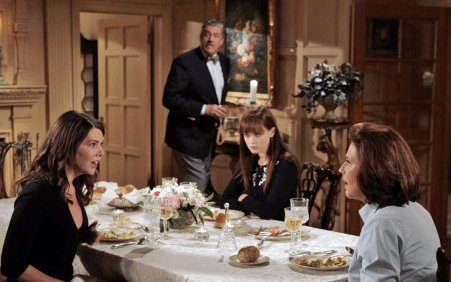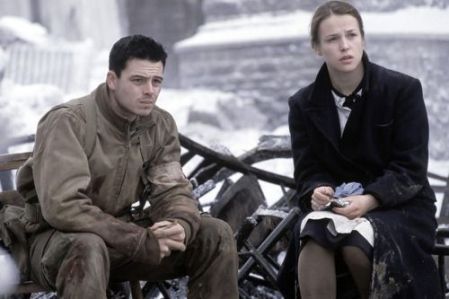6 Questions to Help You Avoid Repetitive Scenes
 It takes a lot of scenes to make a novel. Not only do we need enough scenes to progress the plot and get the characters from Point A to Point B, we also need to reach a certain word count so the book can be a novel. (Or the movie can be a movie. Ya know.) So how can you make sure you’re not just filling out that word count with repetitive scenes?
It takes a lot of scenes to make a novel. Not only do we need enough scenes to progress the plot and get the characters from Point A to Point B, we also need to reach a certain word count so the book can be a novel. (Or the movie can be a movie. Ya know.) So how can you make sure you’re not just filling out that word count with repetitive scenes?
At a certain point, most writers will receive critiques or edits in which whole scenes are circled in red with notes that read “nothing happens” or “they already had this conversation” or “this doesn’t advance the plot” or “feels like you’re padding the word count”—all of which are code for “repetitive scenes.”
Recognizing repetitive scenes can be tricky for authors (hence, the big red circles from critique partners and editors). Our deep immersion in our own stories inevitably causes a certain lack of objectivity. We may think a scene is full of new info when really the characters have already been there done that. Readers may not think too much about one or two repetitive scenes. But at a certain point, they will grow increasingly restless and frustrated with the story’s lack of progress.
A while back, I received an email from Wordplayer Sarah K. with an insightful question:
I’m working on a novel that seems to be lending itself to a lot of “talky” scenes, scenes (in the scene structure sense) where the conflict is typically interpersonal and expressed in dialogue; think lots of parlor arguments, gossip while hunting, etc. I know that not every novel needs to have car chases and sword fighting, particularly in certain genres. But I can’t help but worry that this is a function of something going wrong. My concern is that these scenes are starting to feel repetitive and that this is a symptom of me “telling” the conflict, or even having protagonists that aren’t quite right (i.e., just aren’t witnessing really interesting things firsthand).
Is this something you’ve seen often in unpublished writers? Do you have any insights into varying scene conflict and ensuring that conflict is dramatized in an interesting way?
My response was that there’s nothing wrong with keeping the conflict mostly interpersonal and expressed in dialogue. Many novels operate this way (and, indeed, I’d argue this is often the most interesting type of conflict). But Sarah still raises an excellent point: how do you know whether the scenes you’re writing are simply leisurely and character-driven scenes or whether they are truly repetitious?
Today, I’m going to dive a little deeper into this subject and examine what defines repetitive scenes, as well as strategies for recognizing and avoiding them in your own fiction.
When Repetitive Scenes Are Okay—And When They’re NotAs per Sarah’s example, it’s inevitable that many scenes within a story will be similar to one another. For instance, in a cop story, there will be many scenes of investigating clues. In a romance, there will be many dates between the leads. In an action story, there will be many action scenes. And so on. Additionally, every scene in the entire story will ultimately have the same overarching goal—to find the murderer, resolve the relationship issues, defeat the bad guy, etc. In some respects, every scene is repetitive simply because every scene is a small piece in a larger (and hopefully) unified whole.

Writing Your Story’s Theme (Amazon affiliate link)
Particularly, it’s fine to include “repetition” in the form of thematic motifs or running gags. The latter is particularly obvious in serial works, such as TV shows. Many shows, especially comedies, will open with an isolated scene that stands apart from the main plot but which features a standard running gag of some sort. (The Andy Griffith Show and Gilmore Girls often opened their episodes with a scene in which the characters exchanged a funny conversation about a random topic.)

Thematic motifs also require repetition to become effective. For instance, one confrontation with authority does not a rebel make. But if your character has repeated run-ins with authority figures, then the entire story begins to take on a specific thematic shape. This is not only okay, it’s necessary to the formation of a cohesive and resonant story.
What is not okay is plot-oriented repetition.
6 Questions to Help You Prevent Repetitive ScenesWhat differentiates one repeat scene of a character shoplifting and getting arrested from another repeat scene featuring the same incident?
The simplest criterion is: does the scene change something?
This change might be to the character and the plot itself (e.g., the character is let off with a warning the first time but arrested the second). Or the change could simply be to the readers’ perspective (e.g., the character’s second arrest provides the punchline to a joke or adds new insight into the thematic context).
Of course sometimes what the author intends as thematic repetition will still come across as boring and unnecessary to readers. Fortunately, there are several questions you can ask yourself to analyze whether your scenes are truly advancing the story or whether they are repetitive—and should probably be cut.
1. Is the Character’s Goal the Same as in the Last Scene?Although not a catchall, this is the first and most important question you should ask yourself. As noted, the overarching plot goal will remain essentially the same throughout the story. But the smaller scene goals should still show a progression. If the character’s plot goal is to become President, then the smaller goals will arise in response to various obstacles along the campaign trail.
And what if your story is more relational with a less obvious plot goal? What if, like Sarah’s story, yours is primarily focused on lots of conversations between characters with a vaguer destination of something like “coming to peace with a complicated parent’s passing”? Ultimately, the same guideline applies. Examine how well the characters’ goals are evolving from scene to scene. Are they getting closer to what they want—or farther away? (Either will provide a sufficient movement of the plot circumstances.) If the talking isn’t achieving any movement for any of the characters then examine how you might adjust that from scene to scene.
2. Are the Obstacles the Character Is Facing Different From Previous Scenes?If you find your characters’ scene goals aren’t changing much from scene to scene, the next thing to look at is your scenes’ conflict. Specifically, how are the obstacles evolving? How can you avoid your characters facing the same scene-specific problems in every scene?
It could be that the character’s goal doesn’t change too much for multiple scenes, and that’s okay, as long as the obstacles are changing. If your protagonist is a detective trying to get a conversation with a mob boss, he might have to try several different tactics before he gets what he wants. But if he faces the same obstacle (or a familiar variation on the same obstacle) in every one of those scenes, the action will quickly feel repetitious.
Sometimes realism and pacing demand characters won’t get what they want on the first try. In these instances, you’ll need to evolve their goal subtly from scene to scene by focusing on how they systematically work through various obstacles on their way to the goal.
3. What New Information Is Introduced in This Scene?Even when you find yourself in a situation where you need to include several scenes featuring the same goal and perhaps even very similar obstacles, you can still prevent the scene from feeling repetitious. All you have to do is make sure every scene introduces new information.
This could be information that is new to the protagonist, but it could also simply be new insights for the readers. For instance, the protagonist might reveal a personal secret to another character. This might not directly advance the plot or immediately change the scene goal or conflict, but as long as it deepens the characterization context, it can serve to justify the scene’s existence.
This is a tricky one, since writers must be able to accurately judge whether the new information is truly adding something to the story. If the character’s secret is about how he broke his brother’s bike when they were kids, that secret must either become crucial to the development of the plot later on or offer significant insight into the character’s own personality and motivation.
Additionally, if you’re asking information to carry a scene, that information should be interesting in its own right. Examine it from your readers’ perspective. Why will this information matter to them?
4. Is This the Same Kind of Scene as the Last One (and the Last One and the Last One)?Even if you’re acing the boxes from the previous questions, readers can still sometimes end up feeling scenes aren’t varied enough if all the scenes “look” the same. If every scene is a conversation or every scene is a fistfight or every scene is a make-out session, then the sheer lack of variety may weary readers.
Even genre books need variety. In fact, the contrast offered by varied scenes can create powerful opportunities for thematic subtext. For example, one of my favorite scenes in the Band of Brothers miniseries is one in which a French nurse eats a chocolate bar with the company medic in a bombed-out village. She dies shortly after and he never sees her again. But the quiet relational moment within a heavy war story created both poignant contrast and welcome variety.

This one isn’t crucial. After all, some wonderful stories take place all within the same setting. But if you’re worried your scenes still “feel” too much the same even after examining the previous questions, a comparatively easy tweak is that of changing up the settings.
This can be especially handy in a dialogue-heavy story. Don’t set every conversation at the protagonist’s office or in the same restaurant. Mix it up. Have the characters talk in the car, talk in a pool hall, talk in a church, talk while helping each other move. Although settings should never be random, mixing it up can add surprising new opportunities and dynamics to your stories.
6. Are New Characters Adding New Dynamics That Are Different From Previous Scenes?Finally, examine how well you’re varying the different pieces available to you. Within any given story, you will have a set number of puzzle pieces that you can mix and match. Particularly, you’ll want to shuffle your supporting characters to allow different people to be present in different scenes.
Not only will this change up the “scenery,” it should also give you the opportunity to deepen any given scene’s complexity by bringing in the motives, desires, goals, grudges, etc., of many different personalities. A three-way conversation between your protagonist, her mother, and the local vicar will be a completely different conversation from one between your protagonist, her father, and the local sheriff—even if the topic under discussion is the same.
***
Sometimes recognizing repetitive scenes is the toughest part. After that, the solution (although not fun) is usually pretty easy. Either delete the scene you don’t need and/or combine its important bits with a more comprehensive and important scene. The result will be a much tighter and more interesting story.
Wordplayers, tell me your opinions! Do you ever worry about repetitive scenes in your stories? Tell me in the comments!Click the “Play” button to Listen to Audio Version (or subscribe to the Helping Writers Become Authors podcast in Apple Podcast or Amazon Music).
___
Love Helping Writers Become Authors? You can now become a patron. (Huge thanks to those of you who are already part of my Patreon family!)The post 6 Questions to Help You Avoid Repetitive Scenes appeared first on Helping Writers Become Authors.
 newest »
newest »
 I love how practical and sensible the information in this article is.
I love how practical and sensible the information in this article is.




